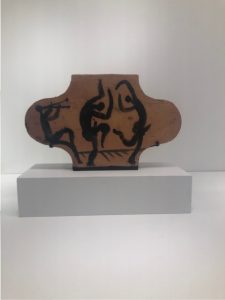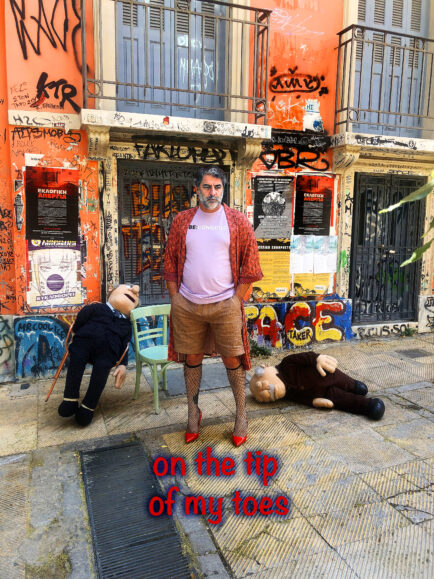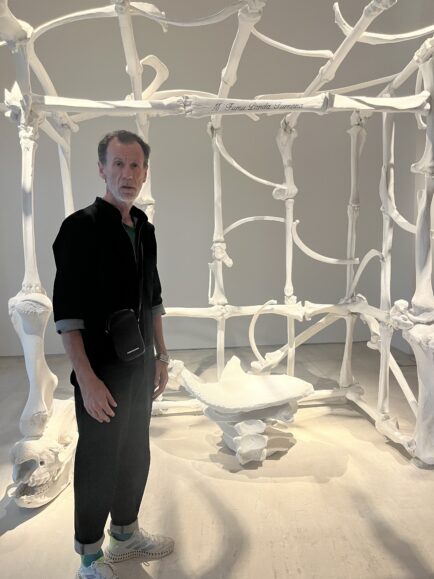Why you should see the special exhibition that takes place in the Museum of Cycladic Art with the title Picasso and Antiquity. Γιατί θα’ πρεπε να δεις την έκθεση που λαμβάνει χώρα στο Μουσείο Κυκλαδικής Τέχνης με τίτλο Πικάσσσο και Αρχαιότητα.
Sixty-eight rare ceramics and drawings by Picasso, featuring birds, animals, sea creatures, humans, and mythological beasts (centaurs, the Minotaur) or inspired by ancient drama and comedies, converse thematically for the first time with sixty-seven ancient works, creating another Divine Dialogue between Greek antiquity and modern art. Για πρώτη φορά 68 σπάνια κεραμικά και σχέδια του Πικάσο με πτηνά, τετράποδα και θαλάσσια όντα, ανθρώπινες μορφές, μυθολογικά ή μειξογενή όντα (Κένταυρος-Μινώταυρος) και άλλα έργα εμπνευσμένα από αρχαίες τραγωδίες και κωμωδίες, «συνομιλούν» θεματικά με 67 αρχαιότητες, δημιουργώντας έναν ακόμη «Θεϊκό Διάλογο» μεταξύ της αρχαίας ελληνικής και της μοντέρνας τέχνης.
 Silenus in the company of dancers. Σειληνός συνοδευόμενος από χορευτές,
Silenus in the company of dancers. Σειληνός συνοδευόμενος από χορευτές,
In this point, it worths to emphasize the similarity between the two artifacts. Σε αυτό το σημείο, αξίζει να τονιστεί η ομοιότητα μεταξύ των δύο αντικειμένων.
 Picasso himself drawning on a mirror. Ο ίδιος ο Picasso ζωγραφίζει επάνω σε καθρέφτη.
Picasso himself drawning on a mirror. Ο ίδιος ο Picasso ζωγραφίζει επάνω σε καθρέφτη.
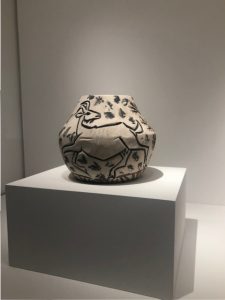 Vase decorated with goats, 1952. Βάζο με κατσίκες, 1952.
Vase decorated with goats, 1952. Βάζο με κατσίκες, 1952.
 Greek warrior ( Paris, 21 January 1934, charcoal on paper, Madrid, Fundacion Almine y Bernard Ruiz-Picasso para el Arte. Έλληνας πολεμιστής (Παρίσι 21 Ιανουαρίου 1934, κάρβουνο σε χαρτί, Μαδρίτη,Fundacion Almine y Bernard Ruiz-Picasso para el Arte)
Greek warrior ( Paris, 21 January 1934, charcoal on paper, Madrid, Fundacion Almine y Bernard Ruiz-Picasso para el Arte. Έλληνας πολεμιστής (Παρίσι 21 Ιανουαρίου 1934, κάρβουνο σε χαρτί, Μαδρίτη,Fundacion Almine y Bernard Ruiz-Picasso para el Arte)
“To me there is no past or future in art. If a work of art cannot live always in the present it must not be considered at all. The art of the Greeks, of the Egyptians, of the great painters who lived in older times, is not an art of the past; perhaps it is more alive today than it ever was”. Marius de Zayas, “Picasso Speaks”, The Arts, May 1923.
“Για εμένα δεν υπάρχει παρελθόν ή μέλλον στην τέχνη. Εάν ένα έργο τέχνης δεν μπορεί να ζει πάντα στο παρόν, δεν μπορεί σε καμία περίπτωση να θεωρείται ως τέτοιο. Η τέχνη των Ελλήνων, των Αιγυπτίων, καθώς και των μεγάλων ζωγράφων που έζησαν σε παλαιότερες εποχές δεν είναι τέχνη του παρελθόντος. Ίσως είναι περισσότερο ζωντανή σήμερα παρά ποτέ”. Marius de Zayas, “Picasso Speaks”, The Arts, May 1923.







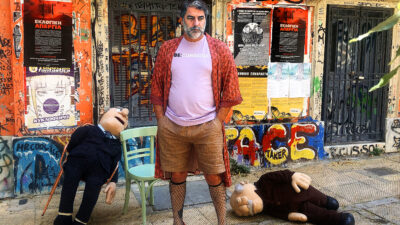





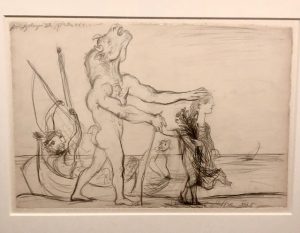 Blind Minotaur Guided by a girl by the sea. Τυφλός Μινώταυρος οδηγούμενος από μικρό κορίτσι μπροστά στη θάλασσα.
Blind Minotaur Guided by a girl by the sea. Τυφλός Μινώταυρος οδηγούμενος από μικρό κορίτσι μπροστά στη θάλασσα. Red Figure calyx krater (attributed to the Group of the Late Calyx-kraters) depicting Theseus vanquishing the Minotaur. Ερυθρόμορφος καλυκωτός κρατήρας (της ομάδας των Ύστερων Καλυκωτών Κρατήρων) με παράσταση Θησέα που καταβάλλει τον Μινώταυρο.
Red Figure calyx krater (attributed to the Group of the Late Calyx-kraters) depicting Theseus vanquishing the Minotaur. Ερυθρόμορφος καλυκωτός κρατήρας (της ομάδας των Ύστερων Καλυκωτών Κρατήρων) με παράσταση Θησέα που καταβάλλει τον Μινώταυρο. Bull figurine (Post-Palatial period 1250-1150 BC) Ειδώλιο ταύρου (Μετανακτορική περίοδος 1250-1150 π.Χ)
Bull figurine (Post-Palatial period 1250-1150 BC) Ειδώλιο ταύρου (Μετανακτορική περίοδος 1250-1150 π.Χ) Spanish plate decorated with an eye and bulls, May 1957. Ισπανικό πιάτο διακοσμημένο με μάτι και ταύρους, Μαίος 1957.
Spanish plate decorated with an eye and bulls, May 1957. Ισπανικό πιάτο διακοσμημένο με μάτι και ταύρους, Μαίος 1957. Picasso with a wicker bull mask originally intended for bullfighters’ training, he becomes a living Minotaur. Beside him is a sculpture made of scrap wood with the features painted on it, 1959. Με μια ψάθινη μάσκα ταύρου, από αυτές που χρησιμοποιούνταν για την εκπαίδευση ταυρομάχων, ο Πικάσσο μεταμορφώνεται σε ζωντανό Μινώταυρο. Δίπλα του, ένα γλυπτό από παλιά ξύλα με ζωγραφισμένες λεπτομέρειες, 1959.
Picasso with a wicker bull mask originally intended for bullfighters’ training, he becomes a living Minotaur. Beside him is a sculpture made of scrap wood with the features painted on it, 1959. Με μια ψάθινη μάσκα ταύρου, από αυτές που χρησιμοποιούνταν για την εκπαίδευση ταυρομάχων, ο Πικάσσο μεταμορφώνεται σε ζωντανό Μινώταυρο. Δίπλα του, ένα γλυπτό από παλιά ξύλα με ζωγραφισμένες λεπτομέρειες, 1959. From left : Bacchanal ( Tomette (tile) in grogged red earthenware, slip-painted, partially glazed. Διονυσιακό ( Πλακίδιο από ερυθρό πηλό, γραπτή με επίχρισμα διακόσμηση, μερικώς εφυαλωμένο ) Right : Lekythos in Six’s technique (attributed to the Chariot Painter) with a scene of three dancing youths. Λήκυθος τεχνικής Six ( του Ζωγράφου του Άρματος ), παράσταση τριών νέων που χορεύουν.
From left : Bacchanal ( Tomette (tile) in grogged red earthenware, slip-painted, partially glazed. Διονυσιακό ( Πλακίδιο από ερυθρό πηλό, γραπτή με επίχρισμα διακόσμηση, μερικώς εφυαλωμένο ) Right : Lekythos in Six’s technique (attributed to the Chariot Painter) with a scene of three dancing youths. Λήκυθος τεχνικής Six ( του Ζωγράφου του Άρματος ), παράσταση τριών νέων που χορεύουν.